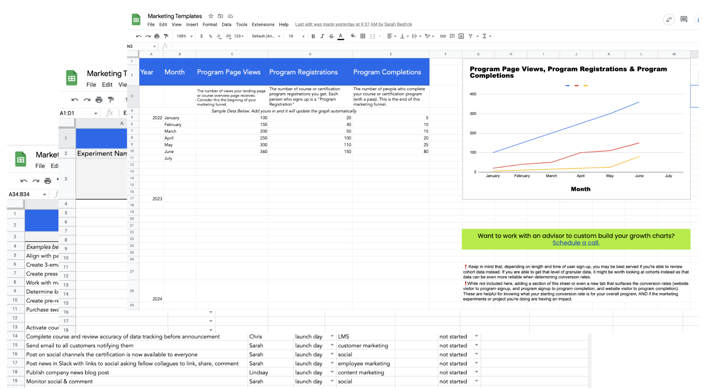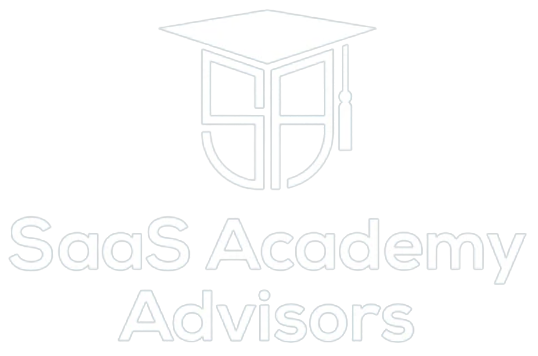It’s been 10 years since Mark Kilens, Chris LoDolce, and I started the HubSpot Academy team.
In honor of this significant milestone, I’m sharing 10 lessons I learned from creating, scaling, and growing the team.
1. Team Purpose
We created our Team Purpose very early on.
Our team purpose was:
“To educate and inspire people, so that we together, transform the way the world does business.”
Our purpose was our north star; it was our reason for existing. Every idea or opportunity that came our way, we filtered through this lens to help us decide what action to take.
Tips I learned from using our purpose to grow:
- Make sure it aligns with the mission of your company.
- Review it frequently. We reviewed ours in every Monthly Team Meeting and frequently in ad-hoc meetings with others.
- Use it to make decisions: Not only did we review it, but we used it to help us align around strategy and tactics.
- Have your team members commit them to memory. When your team knows and can recite your team’s purpose, it will be easier to unify around it.
2. Team Principles
We also created our Team Principles early on.
Our Team Principles were our guideposts and communicated the desired behaviors and characteristics that we wanted to embody on our team.
When we started, we had 7 principles altogether. A few of them were:
Execute with Excellence
Create a Consistent Learning Experience
Never Settle
Stay Weird
These were so central to our team’s behavior and success that each principle could be a separate blog post.
And I could have easily used our principles as the “10 learnings” for this post because we took many actions that improved HubSpot Academy over the years just by living and breathing these principles on a daily basis.
However, the one I believe had the greatest impact was “Stay Weird.”
Despite its intangibility or lack of business and tactical application, it was the one that gave everyone permission to bring their whole, authentic, and unique self to work.
It was an ideal principle because it created psychological safety. And as it turns out, psychological safety builds trust, a cornerstone for high-performing teams
Tips I learned from using our Principles to grow:
- Have team members commit them to memory. When your team knows and believes in your team’s principles and can recite them, behaving in congruence with them will become (almost) automatic.
- Have your team work together to build them. Our original principles and several iterations after were made with everyone’s input.
- Revisit and update them appropriately. We revisited them annually and sometimes made minor tweaks, and others made sweeping overhauls. As the company grows and increases its products or international focus, your principles for educating may change. As the team grows and becomes more specialized, they also may change. If you’re curious about the team’s current principles, check out this post, “ HubSpot Academy’s Eight Guiding Principles .”
- Recognize that some principles may be more prevalent or resonate depending on a person’s job function, the project they’re working on, or the time of year (e.g., annual content updates vs. KPI setting ).
3. Team Operating System
Mark Kilens, the team’s former VP, did an excellent job laying out the three operating systems our team leaned into to help us run efficiently over the years, which you can read here.
In the piece, he said the following about our Operating System:
“The Academy Operating System is the third part of our team’s core. It guides us in everything we do. It’s a resource we use to make sure we’re operating in a manner that’s aligned with our principles and our purpose. We use the operating system to teach others how to create education that’s informative, useful, and enjoyable to consume.”
Our Operating System was a library of playbooks, documents, and resources we created that detailed our processes for everything we did.
From how we onboarded new team professors down to the nitty-gritty of every step of the certification creation process — it was the go-to resource for anyone to get started with anything.
Our Operating System allowed us to move quickly, with consistency and excellence.
4. Hiring
Hire for character, train for skill.
Our team’s first hires were people of wildly different academic backgrounds: history, neuroscience, and philosophy.
We set out to do something unique, innovative and massively value-add, and because the playbook hadn’t been created yet, we always focused on the character of the individuals over their skillset.
Even if we wanted to hire for skillsets, it would have been challenging because there wasn’t much of a candidate pool since nobody in software was doing what we were trying to do (Salesforce’s Trailhead didn’t even exist yet). While there are more people in the industry today, the field is still nascent relative to how significant it will become.
5. Celebrate everything
Our team was obsessed with celebrating.
We celebrated everything, regardless of how small it might seem. We celebrated:
- first instructor-led training class going live
- our first attendees
- when we transitioned all of our ILT content to video
- the launch of every certification
- our LMS the Learning Center going live
- every piece of feedback we received
- and even the personal milestones of our team members like buying houses, getting married, having a birthday, or accomplishing a lifelong dream
Here’s me cheering on team member, Lindsay Thibeault, as she nears the end of the Boston Marathon. Finishing this race was a lifelong dream of hers.

Many years later, and after reading 50+ books on goal attainment, leveling-up, and identity change, it turns out celebrating is a huge part of the success equation.
Here’s BJ Fogg, the author of Tiny Habits, explaining how celebration and reward work:
“Each individual celebration strengthens the roots of a specific habit, but the accumulation of celebrations over time is what fertilizes the entire habit garden. By cultivating feelings of success and confidence, we make the soil more inviting and nourishing for all the other habit seeds we want to plant.”
6. Share or borrow resources
There were many instances, especially at the beginning, where we didn’t have the resources (budget, bandwidth, etc.) to achieve our goals.
That’s when we learned to partner with teams that had similar goals and align with them to create win-win scenarios.
An example of this was in the early days when launching our on-demand videos, we didn’t have any team members with video skills since 100% of our training was instructor-led webinars. Proof of this in the picture below.

Instead of asking for the budget outright for this experiment (which I asked for initially and got a big fat “no”), we aligned with another team and divided an intern’s workload between us for a couple of weeks while we built and tested our on-demand video experiment.
In just a few days, we could see that video was immensely more impactful because of its accessibility and easy-to-consume format, and we ended up launching every single one of our live, instructor-led trainings into the video-first format.
After that launch, we hired a person for video and even bought our first teleprompter, which we promptly celebrated with our new video person.
7. Abundance mindset > Scarcity mindset
Starting a corporate academy or getting buy-in to increase your resources can feel like a Sisyphean task.
Be prepared to encounter many “no’s” along the path.
Executives and other leaders might not understand the overall power and impact that this type of scalable training can have on a business, never mind be ready to allocate limited resources to it.
And let’s face it, when you’ve heard “no” on budget several times, it’s deflating, making it easy for the victim mentality to take over.
You know you’re in a victim mindset when you ask questions like:
- “Why can’t my leadership team see the opportunity here?”
- “Why won’t they let me create this?”
- “How can I build anything of value with no resources?”
Those types of questions are unhelpful and result in taking things personally. And trust me, nobody knows this better than I do because I fell into the spiral quite a few times.
There’s a relevant quote, “Change your questions, change your life,” and by simply changing your questions into more empowering ones, you can change your mindset from scarcity (or victim) to abundance.
When you feel resource-constrained, unsupported, or alone on an island, some more helpful questions to ask are:
- How can I create something amazing with the resources I have today?
- How can I create a compelling vision and plan with metrics that will help my leadership say “heck yes” to this?
- How can I partner with others to grow further and faster?
[If you’re having trouble getting buy-in, we have a Corporate Academy Pitch Template that might help. It’s a proven slide deck template used to get approval for Corporate Academies and learning programs and walks you through the steps of communicating your vision, plans, and metrics for success in an exciting and compelling way.]
8. Teaching Frameworks
Many people don’t know that the current HubSpot Academy that you see today was HubSpot’s third attempt at creating scalable training.
One thing that set us apart from the prior teams was our use of Simon Sinek’s Gold Circle (what we referred to as “Why How What”) framework in teaching.
After watching his TED Talk on How Great Leaders Inspire Action, we knew this was the core framework we’d use to create our training.
This framework not only educates but inspires too, allowing our learners to dream about the bigger picture and see how taking action would benefit their work, careers, and whole lives.

9. Use frameworks from other disciplines
After our certification programs had scalable and fine-tuned repeatable processes, we managed them like a product owner, promoted them like a marketer, and sold them like a sales rep.
There are countless other frameworks to use to help you create, launch, and scale your education programs. Rather than trying to recreate the wheel, it’s easier and more efficient to select proven frameworks and processes from other disciplines.
To see 4 marketing frameworks we used to grow HubSpot Academy, check out our “Marketing Your Learning Program” Templates.

10. Learn to tell stories with data
When we first started, we had zero data and zero data analysis skills. And admittedly, this hampered our ability to grow as rapidly as we could have.
Once we began collecting data and learning how to tell the story, it was easy for people to understand our impact on the organization. More people wanted to help, get involved, or work with us after we got our data stories right.
Finding the correct data for the right time and turning it into an easy-to-digest story is what will make your work clear and compelling. When the value you add is clear, doors of opportunity will open like increased budget and other departments wanting to align.
Learning to collect data and read it to tell a story is an essential skill for every leader.
There are many other lessons I’ll carry with me forever, like communicating internally, aligning with other teams, project managing, stakeholder management, executive sponsorship, marketing, fostering community, and content creation that were just as important as the lessons learned above. These were just the first 10 that came to mind.
If you found this helpful and want me to share more lessons, send me a message on LinkedIn to let me know.
